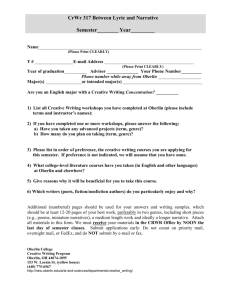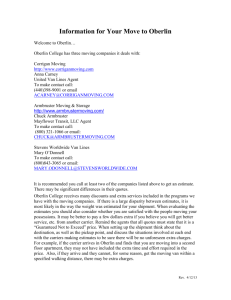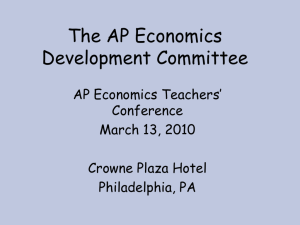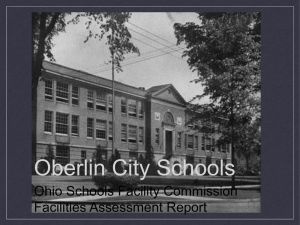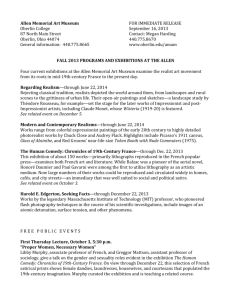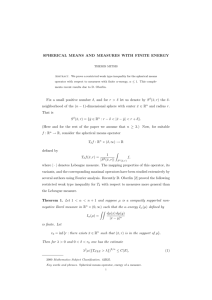Charles Martin Hall (1863-1914) was born in Thompson, Geauga County,... 1863. In 1873, the Hall family moved to Oberlin,... A Self-Guided Walking Tour:
advertisement
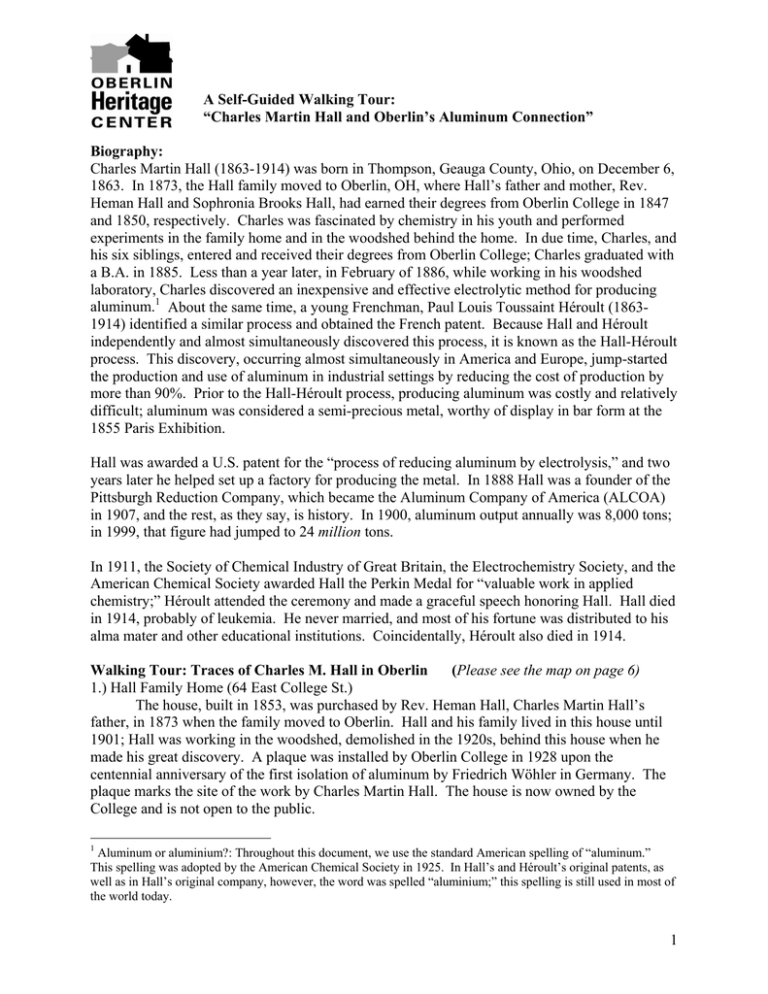
A Self-Guided Walking Tour: “Charles Martin Hall and Oberlin’s Aluminum Connection” Biography: Charles Martin Hall (1863-1914) was born in Thompson, Geauga County, Ohio, on December 6, 1863. In 1873, the Hall family moved to Oberlin, OH, where Hall’s father and mother, Rev. Heman Hall and Sophronia Brooks Hall, had earned their degrees from Oberlin College in 1847 and 1850, respectively. Charles was fascinated by chemistry in his youth and performed experiments in the family home and in the woodshed behind the home. In due time, Charles, and his six siblings, entered and received their degrees from Oberlin College; Charles graduated with a B.A. in 1885. Less than a year later, in February of 1886, while working in his woodshed laboratory, Charles discovered an inexpensive and effective electrolytic method for producing aluminum.1 About the same time, a young Frenchman, Paul Louis Toussaint Héroult (18631914) identified a similar process and obtained the French patent. Because Hall and Héroult independently and almost simultaneously discovered this process, it is known as the Hall-Héroult process. This discovery, occurring almost simultaneously in America and Europe, jump-started the production and use of aluminum in industrial settings by reducing the cost of production by more than 90%. Prior to the Hall-Héroult process, producing aluminum was costly and relatively difficult; aluminum was considered a semi-precious metal, worthy of display in bar form at the 1855 Paris Exhibition. Hall was awarded a U.S. patent for the “process of reducing aluminum by electrolysis,” and two years later he helped set up a factory for producing the metal. In 1888 Hall was a founder of the Pittsburgh Reduction Company, which became the Aluminum Company of America (ALCOA) in 1907, and the rest, as they say, is history. In 1900, aluminum output annually was 8,000 tons; in 1999, that figure had jumped to 24 million tons. In 1911, the Society of Chemical Industry of Great Britain, the Electrochemistry Society, and the American Chemical Society awarded Hall the Perkin Medal for “valuable work in applied chemistry;” Héroult attended the ceremony and made a graceful speech honoring Hall. Hall died in 1914, probably of leukemia. He never married, and most of his fortune was distributed to his alma mater and other educational institutions. Coincidentally, Héroult also died in 1914. Walking Tour: Traces of Charles M. Hall in Oberlin (Please see the map on page 6) 1.) Hall Family Home (64 East College St.) The house, built in 1853, was purchased by Rev. Heman Hall, Charles Martin Hall’s father, in 1873 when the family moved to Oberlin. Hall and his family lived in this house until 1901; Hall was working in the woodshed, demolished in the 1920s, behind this house when he made his great discovery. A plaque was installed by Oberlin College in 1928 upon the centennial anniversary of the first isolation of aluminum by Friedrich Wöhler in Germany. The plaque marks the site of the work by Charles Martin Hall. The house is now owned by the College and is not open to the public. 1 Aluminum or aluminium?: Throughout this document, we use the standard American spelling of “aluminum.” This spelling was adopted by the American Chemical Society in 1925. In Hall’s and Héroult’s original patents, as well as in Hall’s original company, however, the word was spelled “aluminium;” this spelling is still used in most of the world today. 1 2.) Tappan Square. Tappan Square, originally known as “the Campus,” was the site of several of Oberlin College’s academic and residential buildings. After his receipt of the American patent on the Hall-Héroult process and subsequent increase in his income, Hall became a major contributor to Oberlin College. Part of his bequest to the College was used, as stipulated in his will as a precondition to their receipt of the endowment for Tappan Square, to remove the last of the college buildings from the square. Hall was a strong supporter of the early conservation movement and intended this change to increase the green space in town and to create a pleasant, park-like setting for town residents. The only structures now standing in the square are the Clark bandstand, built in 1984 after a national design competition, and the Memorial Arch. In honor of Hall and his contributions to science and to the college, for their fortieth anniversary his classmates financed an aluminum plaque that was set in the brick walkway in the center of Tappan Square. (Local superstition warns that Oberlin College students who step on this plaque will fail to graduate with their class—so watch out!) 3.) Hall Auditorium In his will, Charles Martin Hall also bequeathed to Oberlin College funds earmarked for the building of a large auditorium, to be named after Hall’s mother, Sophronia Brooks Hall, on campus. Though the funds were available to the College by the mid 1920s, the auditorium was not built until 1953 because of controversy surrounding the design and cost of the structure, as well as the national crises of the Great Depression and the advent of World War II, both of which interfered with large construction projects nationwide. Oberlin College President Henry Churchill King advocated the use of the auditorium as a Protestant church and instrumental concert space. He had Cass Gilbert, who had designed several other college buildings, submit a design reflecting these plans: the building was a more-ornate version of Finney Chapel, with a seating capacity of 4,000 in the main auditorium. Four other architects, including Eliel Saarinen, submitted designs, all of which were discarded by the College at the insistence of Homer Johnson, the lawyer serving as the executor of Hall’s will. In 1946 all this jockeying and politicking came to an end with the entry of a new College President, William Stevenson, who selected Wallace Harrison, designer of the United Nations complex in New York, as the designer of the building. Concurrence on the project was secured when Philip Johnson, Homer Johnson’s son and an architect, was retained as a consultant. Though Harrison’s design ran over the budget, after more legal wrangling, the structure, with a seating capacity of just over 500, was built. Its reception was divided, prompting the Cleveland Plain Dealer to call it “the most controversial building in Ohio.” 4.) Allen Memorial Art Museum Particularly during the last 15 years of his life, Charles Martin Hall was an avid collector of art objects, particularly from “the East,” where his older sister, Emily Hall Stimson, had worked as a missionary. Upon his death, most of his collection, particularly oriental rugs and Chinese porcelains, was donated to the Museum, where some of them are still on regular display. 2 5.) First Church Religion played an important role in the Hall family: Charles’ father was a Congregational minister, and both of his parents had been missionaries in Jamaica before the outbreak of the American Civil War. When the Hall family moved to Oberlin, they attended services at First Church. In 1908, Charles donated an Estey organ to First Church that was later replaced. 6.) Severance Chemical Laboratory This structure, designed for Professor Frank Jewett, mentor of Charles Martin Hall, housed the chemistry department from 1901 to 1961. (Before that, chemistry classes had been conducted in Cabinet Hall, which was partly destroyed to make room for Peters Hall.) 7.) Science Center This building occupies the former space and has taken over the role of the Kettering Hall of Science, which formerly housed the biology and chemistry departments. Inside this building, on the second floor above the atrium, is an aluminum statue of Charles M. Hall. On the pillar next to the statue are two plaques related to Hall’s discovery: one from the American Society for Metals naming Oberlin a historical landmark in 1979, and one from the American Chemical Society naming Oberlin a National Historic Chemical Landmark in 1997. 8.) Finney Chapel Hall was one of two donors of the E.M. Skinner-designed organ used in Finney Chapel from 1915 till 1999, when it was dismantled for transportation, renovation, and, finally, installation in Turuo Episcopal Church of Fairfax, Virginia. Hall’s donation of this and the First Church organs indicates religious commitment, of course, but also a strong interest in music. While still a high school student, Hall studied piano in the Conservatory, and all reports indicate that he reached a high level of skill. The most amazing report comes from family members: in Buffalo, New York in the early 1900s, the famous pianist Paderewski was unable to perform a scheduled concert because of illness, and Hall gave an impromptu recital instead. (It is historically documented that Paderewski did not play this concert; there are, as yet, no known historical documents supporting the story that Hall did.) 9.) Peters Hall, and Memorial Arch (facing) The south bay of Peters Hall occupies the space previously occupied by the north wing of Cabinet Hall, the science building where Hall studied for his B.A. Today, Peters houses, among other things, the offices of the Oberlin Shansi Memorial Association, which was supported in part by Hall’s estate. Hall’s older sister, Emily Hall Stimsom, with her husband, was a member of the first group of Oberlin College graduates, in 1882, to go to the Shansi Province of China to teach and do missionary work. The Shansi Memorial Association was founded after the Boxer Rebellion in 1900 in which a number of Oberlin-trained missionaries were killed. The Memorial Arch, facing Peters Hall, was constructed to commemorate the American missionaries killed in the unrest. 3 10.) Jewett House (73 South Professor St.) This house was the residence of Prof. Frank Jewett, professor and mentor of Charles M. Hall, and his wife Frances. Prof. Jewett, an advocate of further research into aluminum and its possible industrial uses, had challenged his students to consider the problems it presented, which further encouraged Hall to continue his research with aluminum. When Hall had successfully produced some globules of aluminum, he showed them to Prof. Jewett, who later provided testimony in support of his patent application. [The Jewett House is open for guided tours administered by the Oberlin Heritage Center, and a significant portion of the Jewett House tour deals with Charles M. Hall and his discovery of the Hall-Héroult process. Tours begin at the Monroe House, 73 ½ South Professor Street; contact the Oberlin Heritage Center at (440)774-1700 or visit http://www.oberlinheritage.org for more information.] 11.) Johnson House (216 South Professor St.) This house was built in 1885 for members of the Johnson family, who made their fortune off banking, gasworks, and railroads. In 1911, Hall bought the property and donated it to the College. From 1911 till 1916, it housed the Oberlin Academy; from 1916 to the present, it has been used as a residence hall, currently as the Jewish/Hebrew Studies program hall. 12.) Hall Arboretum In his will, Charles Hall gave property along Plum Creek to the College with the stipulation that it, along with adjoining Johnson property, be made into an arboretum and forest preserve. He specified that specimens from all over the world that would grow in Oberlin’s climate be planted and that various measures be included to encourage bird life. This property, which stretches from South Professor Street to Pyle South Amherst Road, was called the Hall Arboretum. 13.) Westwood Cemetery Westwood Cemetery, Oberlin’s second cemetery, was officially opened in 1865. The Hall family plot, in Section E., is reached by bearing right on the paved path past the first section of graves. Buried there behind a large stone labeled “Hall” are Charles Martin Hall, his parents Heman B. and Sophronia Brooks Hall, and siblings Ellen Hall Kinsey and Lewis A. Hall. To the right is the Stimson plot including the graves of Hall’s sister Emily Hall Stimson and her family. 14.) The Second Hall House (280 Elm Street) Charles Hall had this new and larger home built for his family in 1901. His father and three of his sisters lived here until about 1910. In 1911, Hall’s father died, and his sisters moved to Rochester, New York. From this time until 1915, when the house passed out of the Hall family, Hall’s older brother, George, and his family lived here. 4 The Legacy of Charles Martin Hall, at Oberlin and Beyond In many ways, Charles Martin Hall is a prototypical Oberlin student. Many of Hall’s interests are also the interests of Oberlin College students today: science, the conservation movement, classical music, the visual arts, and international study/study abroad. The bequests from the Hall estate promoted the growth of strong programs in these fields of study and helped Oberlin College to become eminent in higher education in America. Outside Oberlin, Hall also contributed to organizations that promoted education, equal opportunity, and inter-cultural understanding. He supplied the endowment of Berea College, in Berea, Kentucky, that was modeled after Oberlin and where his elder sister Ellen taught for a year and where his college Professor of Greek, William Goodell Frost, later became college president. Hall also donated funds to O.H.I.O. (the Oberlin Historical and Improvement Organization), the predecessor organization of the Oberlin Heritage Center, to begin its endowment. Hall also left funds to the American Missionary Association, under which his parents had worked before his birth and his brother George had served as a fundraiser in Chicago, to support the development of colleges for African-American students in the American South. In addition, the estate administrators assigned endowment funds to the Oberlin Shansi Memorial Association and to the Harvard-Yenching Institute. These gifts came from the third of the Hall estate dedicated to the furtherance of “education in Asia,” which also provided endowment funds for about twenty colleges from Greece to Japan, as chosen by the administrators of the estate. For Further Information: Blodgett, Geoffrey, Oberlin Architecture, College & Town: A Guide to its Social History, Oberlin College, Oberlin, OH: 1985. Nichols, Sarah, ed., Aluminum by Design: Jewelry to Jets, Carnegie Museum of Art, Pittsburgh, Pennsylvania: 2000. This tour is adapted from a previous version written by Professor Emeritus of Chemistry Norman Craig in 1997, when Oberlin was named a National Historic Chemical Landmark. V. 2 - 11/2/07 73 ½ South Professor Street P.O. Box 0455 Oberlin, OH 44074 (440) 774-1700 www.oberlinheritage.org 5 • Begin at Hall House [1] (64 East College St.), just east of Oberlin Inn. • Return to the intersection of College and Main Streets and follow the diagonal path to the center of Tappan Square [2]. • Turn back east and follow the brick walkway that leads toward Hall Auditorium [3]. • Follow Main Street north to the Allen Memorial Art Museum [4] at the intersection of North Main and Lorain. • Kitty-corner from the Art Museum is First Church [5]. • Follow West Lorain west, passing Severance Hall [6] and the Science Center [7]. • Double back on West Lorain to the intersection of West Lorain and Professor, where Finney Chapel [8] is located; Head south on Professor Street, past the Memorial Arch and Peters Hall [9], where Cabinet Hall stood. • Continue south on South Professor, past the Jewett House [10], until you reach the Johnson House [11] (216 South Professor). • Just beyond Johnson House is one of the entrances to the Hall Arboretum [12]. You could elect to go all the way through the Arb by entering it here and heading west on the trails through it, or you can return to Morgan St. (last intersection passed before Johnson House) and head west on it. Another entrance to the Arb is located behind the reservoirs that you’ll pass, and another a bit further on where Cedar St. intersects with Morgan. • Continue west on Morgan Street to Westwood Cemetery [13]. • Head back east on Morgan Street. Turn north (left) at the intersection with South Prospect and go three blocks to Elm. Turn east (right) and find the Second Hall House [14] at 280 Elm. • To return to Tappan Square/the center of town, continue east for two more blocks and then turn to the north (left) for one more block. 6
